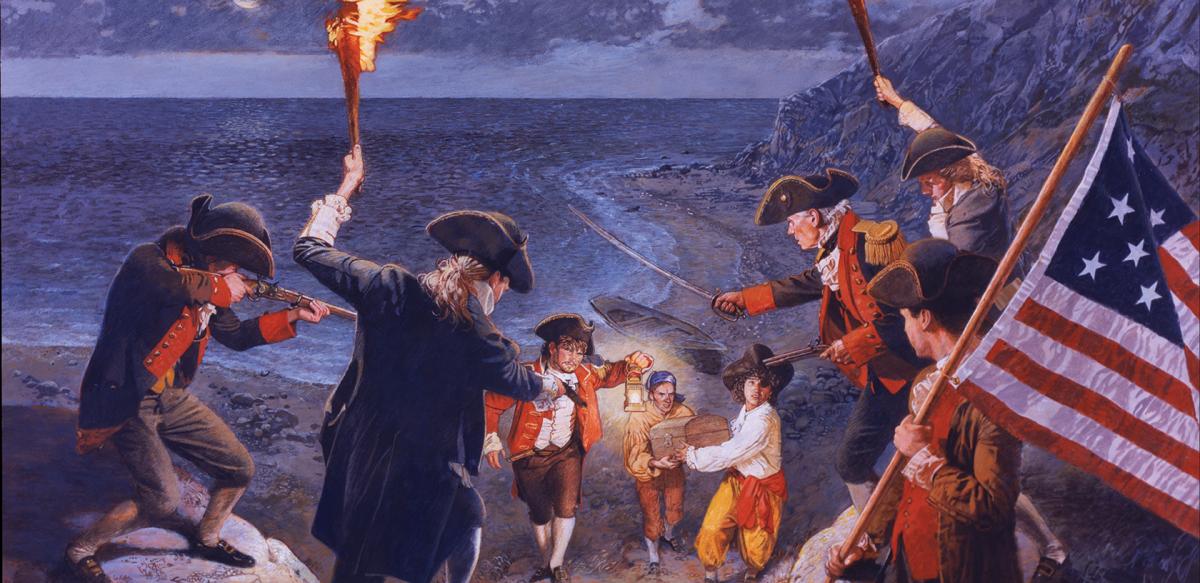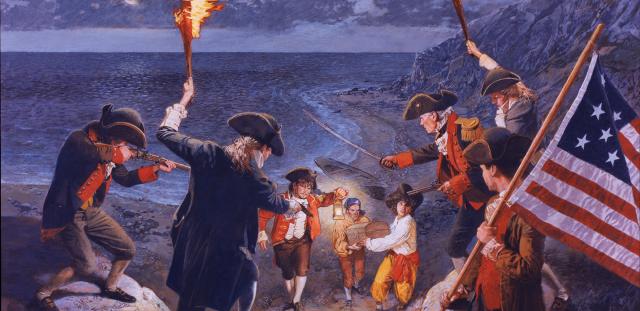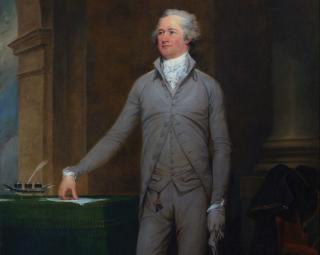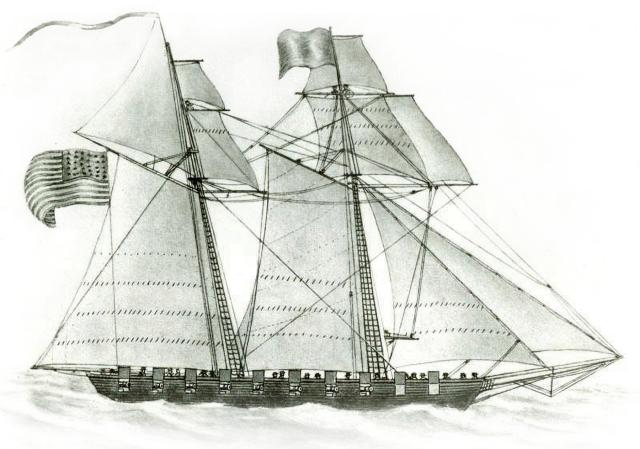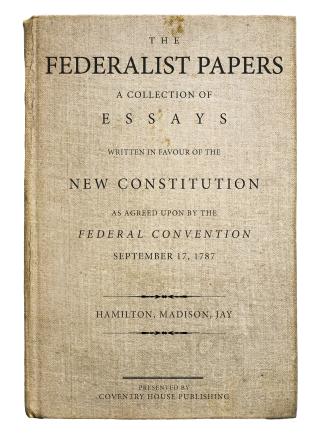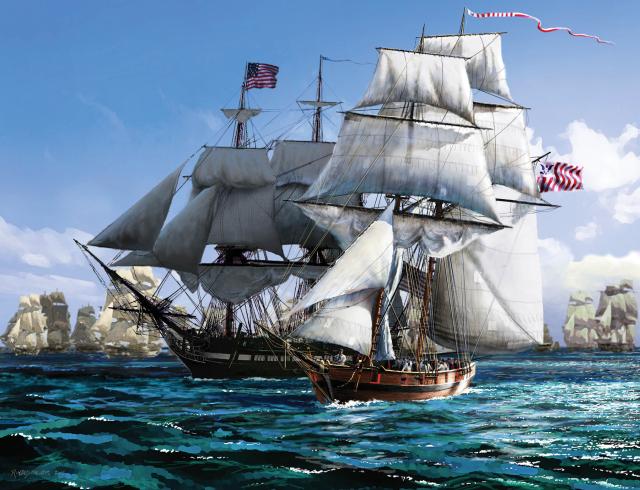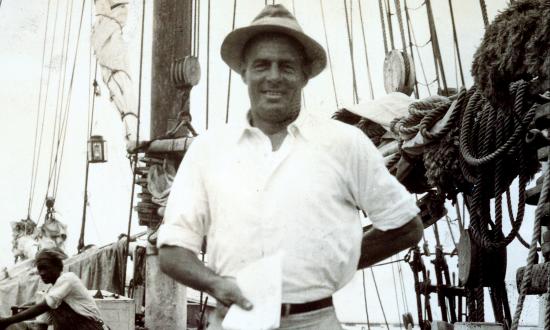Nestled deep in the legislative records of the First U.S. Congress rests the creation of the Revenue Cutter Service.1 At a critical and divided time in U.S. history, Alexander Hamilton used his power as Secretary of the Treasury to send forth a federally armed seagoing force, ostensibly to aid in the collection of revenue. The service emerged as a calculated attempt not only to further strengthen the authority of his massive Treasury Department, but also to fan the flames of Federalism and further Hamilton’s unifying vision for America.
The Coastal Smuggling Culture
After the United States achieved its independence, the nation inherited a well-entrenched smuggling network that undermined revenue collection efforts of both state and federal governments. For decades, Great Britain had struggled to curtail this age-old practice both at home and in the colonies. While smuggling flourished on both sides of the Atlantic, the organic political values of the United States necessitated great caution in applying federal authority to address the problem.2
Hamilton sought a realistic approach to reconcile previous efforts to curb smuggling with the values of the new United States. Limited in size, the Revenue Cutter Service would avoid the heavy-handed strategies of the last years of British rule, but Hamilton did not hide the fact that he sought to “duplicate England’s great achievements in political economy and public policy.”3 According to one biographer, the English model served as “Hamilton’s true lodestar in public finance.”4 England’s ability to tax and collect formed a basic model Hamilton sought to duplicate in the United States. Yet, at the same time, he remained fully aware of the pitfalls of the British approach and demonstrated caution to prevent the same mistakes in the United States.
Questions arose in the months before the Revenue Cutter Service’s creation and appeared in the pages of newspapers across country. In Charleston, South Carolina, one concerned citizen drew a direct parallel between the proposed revenue cutters and the past “ineffectual” British solution of revenue cruisers.5 England’s mistakes, however, in which the army played an increasingly dominant role in domestic affairs, were not an option for the United States.6 Not only did the nascent nation lack a military to fall back on, but it also lacked the funds to raise one. This necessitated an efficient force of men and ships capable of accomplishments typical of a much larger and better equipped fleet. The revenue cutters also needed to maintain the respect and independence of maritime trade in their new nation while being committed to the merits of Hamilton’s Federalist program.
The Birth of the Service
The Revenue Cutter Service marked a turning point for Hamilton’s inchoate Treasury Department. Begun in legislation passed by the First U.S. Congress on 4 August 1790, the establishment of the service took up only a small portion of the 35th chapter of the Second Session. Hamilton’s efforts at revenue collection were, until that point, limited to customs collectors based at U.S. ports. Armed with ten seagoing cutters, Hamilton’s Treasury extended its reach into the bays, rivers, and open waters that offered innumerable opportunities for smugglers to circumvent the efforts of customs officials and undermine the legitimacy of the federal government.
At the same time, the birth of the Revenue Cutter Service marked a significant achievement for Hamilton and his fellow Federalists. The cutters, vested with federal authority, extended central sovereignty over the states by a demonstrable show of force in the Atlantic Ocean and its many tributaries. While the land-based collectors remained confined to their respective ports, the revenue cutters sailed freely among the states and wove in their wake the fibers of federal authority. These cutters reflected the legitimacy and viability of Hamilton’s lifelong quest for national unification under one supreme government.
Hamilton presented his plan for the Revenue Cutter Service to Congress but indicated his concern about the quickness of its implementation. He alluded to his willingness to consider alternate methods in his “Report on Public Credit,” and this openness toward new ideas ultimately defined the revenue cutters. Hamilton wrote of himself:
The Secretary . . . will not presume, that the plan, which he shall submit to the consideration of the house, is the best that could be devised. But it is the one, which has appeared to him freest from objections of any, that has occurred of equal efficacy. He acknowledges too, that it is susceptible of improvement, by other precautions in favor of the revenue, which he did not think it expedient to add.7
Hamilton’s correspondence with his collectors had led to the idea for maritime revenue collection. He sent the first of several circulars to his customs collectors regarding the use of boats for enforcement in the months before he addressed Congress. His request solicited his collectors’ opinions regarding the “expedience of employing them [boats] in your quarter” but initially did not advocate their use.8 Slowly convinced of their value, Hamilton remained cautious. In May 1790, he wrote to Otho Williams, the collector in Baltimore, and suggested that “revenue boats might be purchased or built merely for harbor service.”9 His letter and his “Report on Public Credit” indicated Hamilton approved of the idea of revenue cutters but did not always advocate for the service in the way often portrayed in maritime history. Faced with uncertain political ramifications of a federal paramilitary force at a tense period in U.S. history, Hamilton moved forward with exceptional caution.
The First Congress treated the Revenue Cutter Service with great attention to detail. For the revenue officers on board the cutters, pay matched a salary commensurate with army rank.10 Whereas England paid its naval officers a share of seized goods through the vice-admiralty court system, Hamilton avoided this contentious system entirely.11 A fixed pay scale avoided the pitfalls of heavy-handed enforcement on the part of the revenue cutters.
Hamilton initially requested naval commissions for his revenue cutter officers and argued that “this will not only induce fit men the more readily to engage but will attach them to their duty by a nicer sense of honor,” but later agreed on titles similar to those of merchant vessels.12 The subtle difference in pay still brought the Revenue Cutter Service closer to military standards, but the denial of rank indicated the caution that characterized Hamilton’s progress. Military rank also threatened to ignite Hamilton’s opponents amid the possible cries of a secret naval buildup.
Insistent on efficient limited government, Hamilton imposed financial constraints on the cutters’ construction. He ordered the vessels to cost no more than $10,000—less than $1,000 apiece.13 Hamilton’s customs officials were quick to complain about the minimal funding. Benjamin Lincoln, the customs collector in Boston, wrote the Secretary less than a month after the bill’s signing and argued it unreasonable to outfit cutters for duty in the rough North Atlantic for less than $1,000 dollars each.14 Sharp Delaney, the collector in Philadelphia, raised the same concerns and remarked in a letter to Hamilton that “the time is near at hand when [cutters] of greater magnitude will be found undoubtedly necessary.”15 This occurred at a time when Congress authorized $1,500 for the completion of a single lighthouse in Maine.16 As a tool for revenue collection, the Revenue Cutter Service found itself limited in size and funding, but as a symbolic step in furthering the Federalist cause, it also reflected Hamilton’s desire for minimal political opposition to his seagoing experiment in federal expansion.
Hamilton also spread the construction of the cutters to shipyards across the states. While centralized construction in one region or even one shipyard presented less complicated logistics, Hamilton advised President George Washington “to avoid dissatisfaction it may appear best to build them in different parts of the Union.”17 The cutters ultimately were built in the states where they would be assigned for revenue duty.
Hamilton took great care to instruct the first commanding officers both as to their duties and conduct. Aware of smugglers’ tactics, he advised his revenue officers to recognize these tricks and to respect the rights of Americans to the greatest extent possible. He emphasized:
The provisions of these sections admonish you to keep a careful eye upon the motions of coasting vessels, without, however, interrupting or embarrassing them unless where some strong ground of suspicion requires that they should be visited and examined.18
Hamilton’s Revenue Cutter Service bore no similarity to the brazen actions of 18th-century naval officers. Rather, his revenue officers were reminded of their allegiance to the nation rather than to their particular service, state, region, or pride—a distinction that reflected Hamilton’s own views on loyalty to the nation.19 The revenue cutters served as a physical representation of responsible government.
Hamilton’s letter of instruction placed additional responsibilities on the Revenue Cutter Service beyond the scope of the initial congressional act. In addition to the duties associated with revenue collection, he gave his commanding officers opportunities for service more closely in line with his undeclared aims, writing:
It has also occurred that the cutters may be rendered an instrument of useful information, concerning the coast, inlets, bays and rivers of the United States, and it will be particularly acceptable if the officers improve the opportunities they have (as far as shall be consistent with the duties they are able to perform) in making such observations and experiments in respect to the objects, as may be useful in the interests of navigation, reporting the result, from time to time to the Treasury.20
The expanded role marked a departure from an otherwise straightforward charter and indicated Hamilton’s appreciation for the potential of his Revenue Cutter Service. This intentional addition of duties aligned the service with his ulterior motive in its creation—the exercise of federal authority over the states.
U.S. Politics in the Late 18th Century
Much of post-Revolutionary America remained deeply suspicious of perceived excesses in federal power. In the United States, no dialogue captured this bitter debate better than the exchange of ideas presented in the Federalist Papers and Anti-Federalist Papers. Hamilton, as a principal contributor to the Federalist Papers, summarized the common viewpoint in “Federalist Number One,” when he wrote:
The obvious interest of a certain class of men in every state to resist all changes which may hazard a diminution of the power, emolument, and consequence of the offices they hold under the state establishments; and the perverted ambition of another class of men, who will either hope to aggrandize themselves by the confusions of their country, or will flatter themselves with fairer prospects of elevation from the subdivision of the empire into several partial confederacies than from its union under one government.21
Hamilton lamented the efforts of his opponents to divide the country and resist the realization of a unified federal government.
Looming on the horizon, the Revenue Cutter Service posed a threat to the Anti-Federalists’ views. Anti-Federalists believed that the proposed Constitution was “aristocratic in origin and intent.”22 Chief among the Anti-Federalist beliefs was the idea that “republican government was possible only for a relatively small territory and a relatively small and homogenous population.”23
A recent Hamilton biographer argued that the Treasury itself served as the nucleus of Anti-Federalist concerns
because of its close similarity to the British institution of the Chancellery of the Exchequer.24 In this view, Hamilton’s Treasury Department existed as “the most important of the new executive departments.”25 For his Treasury to succeed, Hamilton needed to demonstrate its viability through effective enforcement of the revenue laws. While this warranted a massive increase in customs officials, Hamilton instead sent forth only ten cutters—a limit imposed out of calculation but also respect for his opponents’ concerns over a rapid increase in federal authority and presence.
Hamilton’s Search for a Solution
The Revenue Cutter Service served not as a final effort to save the Treasury, but as another tool to assist in collection efforts. The symbolic importance of the service trumped its value as a means of revenue collection. Hamilton’s successful policies already had reversed the trends of increasing debt even before the Revenue Cutter Service was formed. By late 1790, the United States possessed a surplus in funds, and Hamilton oversaw a “healthy burst of economic growth.”26 Yet, he remained cautious of the “ingrained American aversion to taxation.”27 With the economy improved, Hamilton achieved not only a minor addition to the tools available for revenue collection, but also a major step toward expanded federal power.
Smuggling served as the apparent impetus for the Revenue Cutter Service. In response to the persistence of coastal smuggling, the revenue cutters acted as the most mobile arm of Customs Service. The less-transparent role of the service addressed Hamilton’s life-long goal of unification. Aware of the political volatility in the late 18th century, Hamilton created the Revenue Cutter Service to demonstrate the potential for effective, efficient, and responsible government.
Rather than an ostentatious private navy could ensure quick victory over his political opponents and smugglers alike, Hamilton demonstrated great regard for the entirety of his nation rather than his political party. The Revenue Cutter Service manifested itself more as a compromise among the various factions than a surefire victory for the Federalist Party. Often clever and cunning in his political intercourse, Hamilton’s creation of the Revenue Cutter Service epitomized the matchless conduct of a true statesman—a quality that placed Alexander Hamilton firmly in the ranks of America’s Founding Fathers.
1. While the Congressional Record from 4 August 1790 does not specifically use the term “Revenue Cutter Service,” it referenced “revenue cutters” and “revenue officers.” From this, the Revenue Cutter Service was born. In 1915, the Revenue Cutter Service was renamed the U.S. Coast Guard and subsequently absorbed several other services over the years, namely, the U.S. Lifesaving Service and the U.S. Lighthouse Service, to become what is now known as the U.S. Coast Guard. See www.uscg.mil/history/ for the official history.
2. Bernard Bailyn, The Origins of American Politics (New York: Vintage Books, 1970), 13.
3. Gordon S. Wood, Empire of Liberty: A History of the Early Republic: 1789–1815 (Oxford: Oxford University Press, 2009), 93.
4. Ron Chernow, Alexander Hamilton (New York: Penguin Press, 2004), 295.
5. “Legislative Acts and Legal Proceedings,” City Gazette and Daily Advertiser, 15 June 1790, vol. 3, no. 4995, 2.
6. J. A. Houlding, Fit for Service: The Training of the British Army, 1715–1795 (Oxford: Clarendon Press, 1981), 78.
7. Alexander Hamilton, “Report on Public Credit,” 4 June 1791, in The Papers of Alexander Hamilton, Harold C. Syrett and Jacob E. Cooke, eds., vol. 8 (New York: Columbia University Press, 1965), 6:101.
8. Alexander Hamilton, “Circular to the Collectors,” The Papers of Alexander Hamilton, vol. 8, 5:420.
9. Alexander Hamilton to Otho H. Williams, 24 May 1790, in The Papers of Alexander Hamilton, vol. 6, (New York: Columbia University Press, 1962), 429.
10. First Congress, Second Session, Ch. 35, Sec. 63.
11. Thomas M. Truxes, Defying Empire: Trading with the Enemy in Colonial New York (New Haven: Yale University Press, 2008), 157, 173.
12. Alexander Hamilton, “Report on Defects in the Existing Laws of Revenue,” 22 April 1790, in The Papers of Alexander Hamilton, vol. 6, 381.
13. First Congress, 2nd Session, Ch. 35, Sec. 62.
14. Benjamin Lincoln to Alexander Hamilton, 17 September 1790, in The Papers of Alexander Hamilton, vol. 7, (New York: Columbia University Press, 1963), 57.
15. Sharp Delaney to Alexander Hamilton, 7 October 1790, in The Papers of Alexander Hamilton, vol. 7, 98.
16. Annals of the Congress of the United States, First Congress, Second Session, Ch. 41, “An Act authorizing the Secretary of the Treasury to Finish the Lighthouse on Portland Head, in the District of Maine.”
17. Alexander Hamilton to George Washington, 10 September 1790, in The Papers of Alexander Hamilton, vol. 7, 31.
18. Alexander Hamilton, “Treasury Department Circular to the Captains of the Revenue Cutters,” 4 June 1791, in The Papers of Alexander Hamilton, vol. 8, 426.
19. John Steele Gordon, Hamilton’s Blessing: The Extraordinary Life and Times of Our National Debt (New York: Walker and Company, 1997), 17, 20.
20. Alexander Hamilton, “Circular to the Captains,” 8:432.
21. Alexander Hamilton, “The Federalist No. 1,” 27 October 1787, in The Papers of Alexander Hamilton, vol. 4 (New York: Columbia University Press, 1962), 302.
22. Cecelia M. Kenyon, “Men of Little Faith: The Anti-Federalists on the Nature of Representative Government,” The William and Mary Quarterly 12, Third Series, no. 1 (January 1955): 5.
23. Kenyon, “Men of Little Faith,” 6.
24. Chernow, Alexander Hamilton, 281.
25. Gordon, Our National Debt, 17.
26. Robert E. Wright, One Nation Under Debt: Hamilton, Jefferson, and the History of What We Owe (New York: McGraw Hill, 2008), 342.
27. Wright, One Nation Under Debt.



